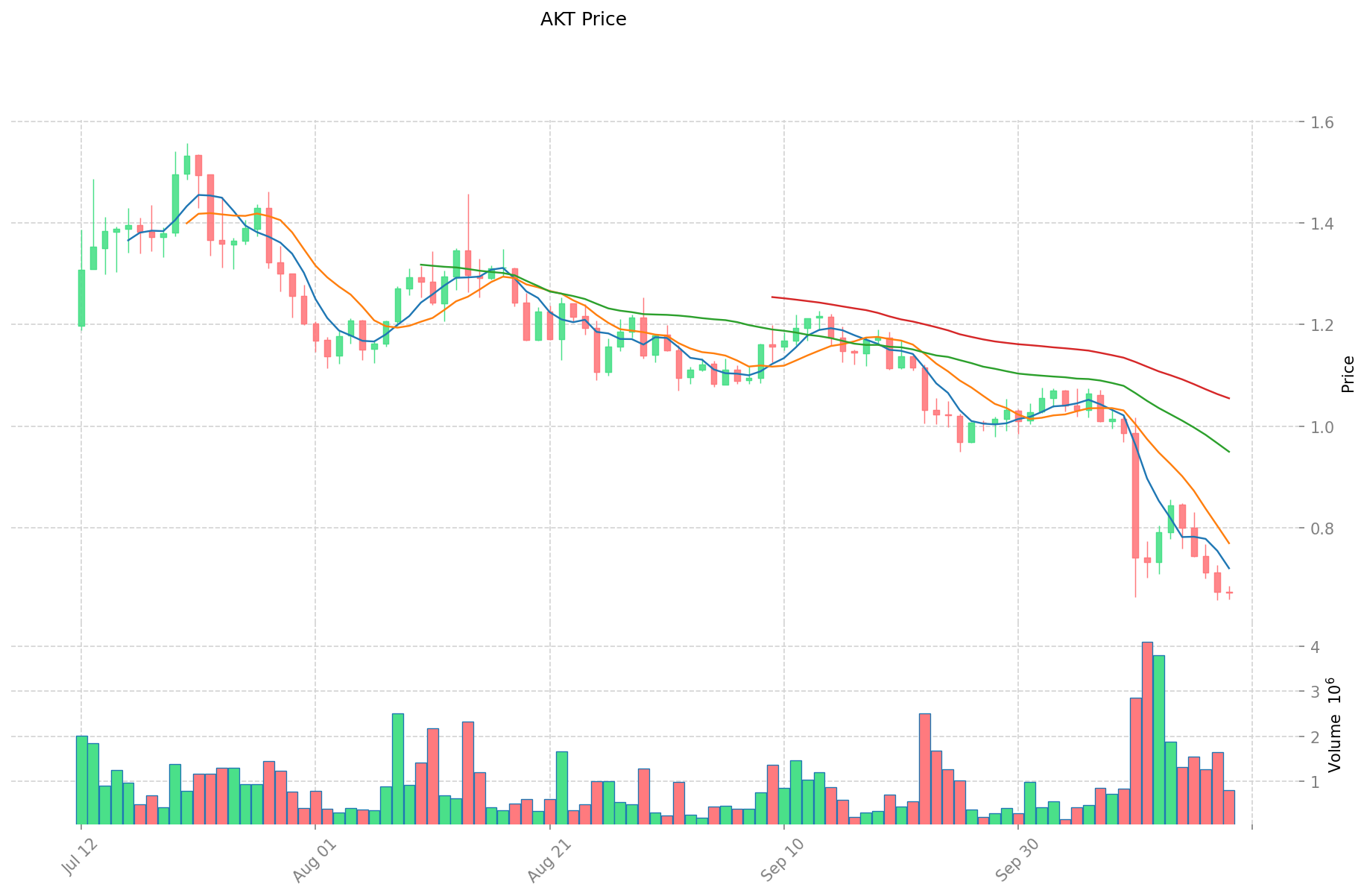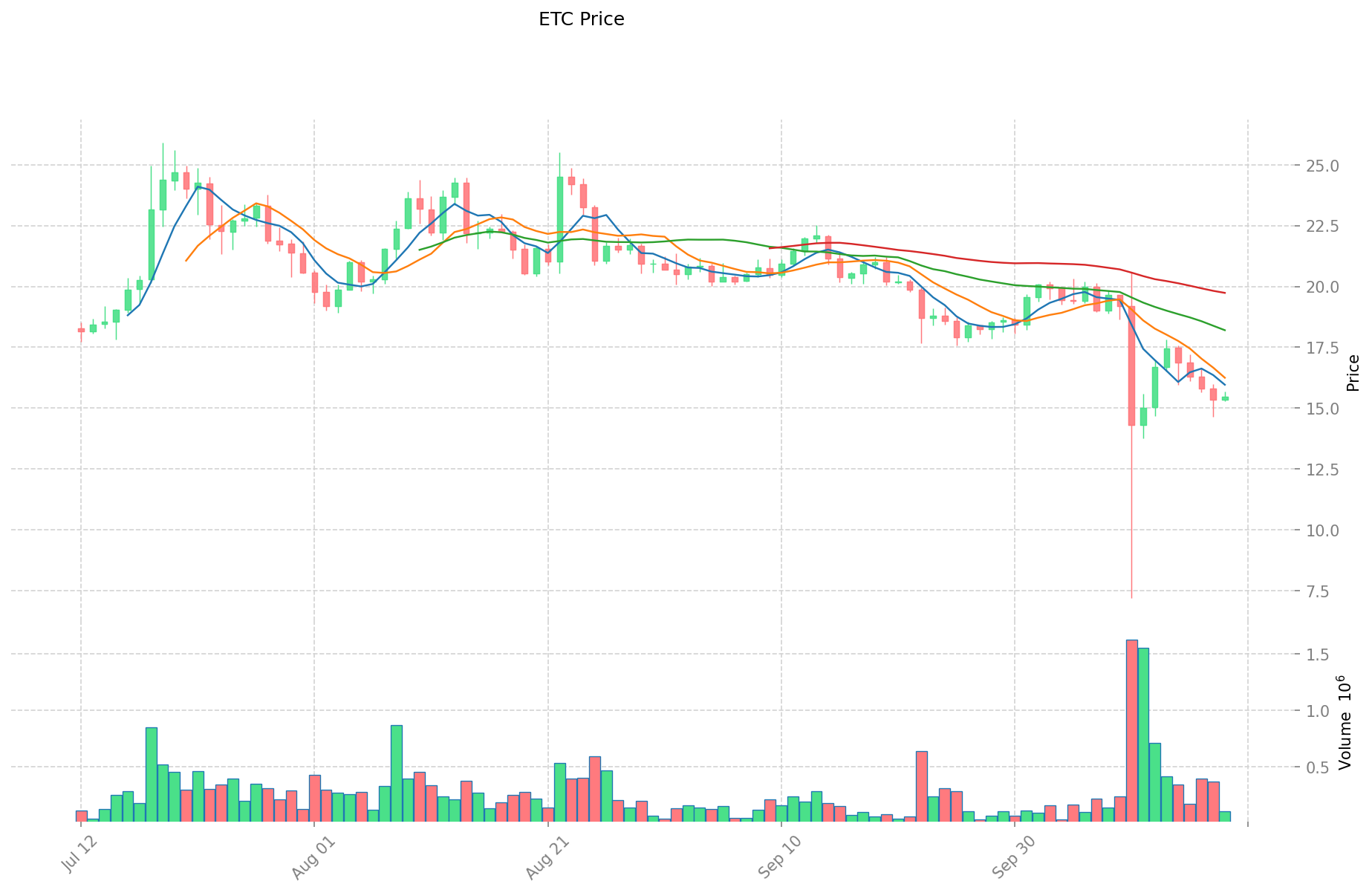AKT vs ETC: Unraveling the Key Differences in Cellular Signaling Pathways
Introduction: AKT vs ETC Investment Comparison
In the cryptocurrency market, the comparison between Akash Network (AKT) and Ethereum Classic (ETC) has always been a topic that investors can't avoid. The two not only have significant differences in market cap ranking, application scenarios, and price performance, but also represent different positioning in crypto assets.
Akash Network (AKT): Since its launch, it has gained market recognition for its decentralized cloud computing marketplace.
Ethereum Classic (ETC): Since 2016, it has been hailed as a platform for executing smart contracts without intermediaries, and is one of the cryptocurrencies with high global trading volume and market capitalization.
This article will comprehensively analyze the investment value comparison between AKT and ETC, focusing on historical price trends, supply mechanisms, institutional adoption, technological ecosystems, and future predictions, and attempt to answer the question that investors are most concerned about:
"Which is the better buy right now?"
I. Price History Comparison and Current Market Status
AKT and ETC Historical Price Trends
- 2021: AKT reached its all-time high of $8.07 on April 7, 2021, likely due to increased interest in decentralized cloud computing.
- 2021: ETC hit its all-time high of $167.09 on May 7, 2021, possibly influenced by the broader cryptocurrency bull market.
- Comparative analysis: In the recent market cycle, AKT has fallen from its high of $8.07 to a current price of $0.6703, while ETC has declined from $167.09 to $15.468.
Current Market Situation (2025-10-19)
- AKT current price: $0.6703
- ETC current price: $15.468
- 24-hour trading volume: $541,912.45 (AKT) vs $1,590,758.56 (ETC)
- Market Sentiment Index (Fear & Greed Index): 23 (Extreme Fear)
Click to view real-time prices:
- Check AKT current price Market Price
- Check ETC current price Market Price


II. Core Factors Affecting the Investment Value of AKT vs ETC
Supply Mechanism Comparison (Tokenomics)
- AKT: Inflationary model with an initial supply of 100 million tokens and a target annual inflation rate of 10%, which adjusts based on the number of tokens staked.
- ETC: Fixed supply with a maximum cap of 210.7 million coins, following a disinflationary model with reducing block rewards similar to Bitcoin.
- 📌 Historical Pattern: Capped supply assets like ETC tend to appreciate over time due to scarcity, while inflationary tokens like AKT rely more on utility and token burn mechanisms to maintain value.
Institutional Adoption and Market Applications
- Institutional Holdings: ETC has greater institutional backing through Grayscale's ETC Trust and inclusion in various crypto indices.
- Enterprise Adoption: AKT is focused on cloud computing infrastructure with Cloudmos as its flagship application, while ETC serves primarily as a store of value and payment system.
- Regulatory Attitude: ETC benefits from regulatory clarity as an established asset, while AKT faces uncertainty as part of the newer cloud computing token category.
Technical Development and Ecosystem Building
- AKT Technical Upgrades: Recent implementation of the Mainnet 5 "Freya" upgrade improved governance and smart contract capabilities, enhancing Akash Network's compute marketplace.
- ETC Technical Development: Maintains the original Ethereum vision with POW consensus, focusing on security improvements following historical 51% attacks.
- Ecosystem Comparison: AKT's ecosystem centers around decentralized cloud computing with growing DeFi applications, while ETC has a more mature ecosystem with multiple wallets, exchanges, and mining pools.
Macroeconomic and Market Cycles
- Performance in Inflationary Environments: ETC is positioned as "digital gold" with stronger inflation-resistant properties due to its capped supply.
- Macroeconomic Monetary Policy: ETC typically shows stronger correlation with traditional risk assets during interest rate shifts, while AKT's performance is more tied to cloud computing sector growth.
- Geopolitical Factors: AKT potentially benefits from global cloud sovereignty concerns, while ETC benefits from situations where censorship-resistant value storage is needed.
III. 2025-2030 Price Prediction: AKT vs ETC
Short-term Prediction (2025)
- AKT: Conservative $0.35-$0.67 | Optimistic $0.67-$0.74
- ETC: Conservative $10.96-$15.44 | Optimistic $15.44-$18.84
Mid-term Prediction (2027)
- AKT may enter a growth phase, with an estimated price range of $0.53-$0.93
- ETC may enter a bull market, with an estimated price range of $13.44-$26.30
- Key drivers: Institutional capital inflow, ETF, ecosystem development
Long-term Prediction (2030)
- AKT: Base scenario $0.96-$1.10 | Optimistic scenario $1.10-$1.31
- ETC: Base scenario $24.56-$28.89 | Optimistic scenario $28.89-$30.33
Disclaimer
AKT:
| 年份 | 预测最高价 | 预测平均价格 | 预测最低价 | 涨跌幅 |
|---|---|---|---|---|
| 2025 | 0.73623 | 0.6693 | 0.354729 | 0 |
| 2026 | 0.96278805 | 0.702765 | 0.51301845 | 4 |
| 2027 | 0.932709708 | 0.832776525 | 0.532976976 | 24 |
| 2028 | 0.91805284116 | 0.8827431165 | 0.820951098345 | 31 |
| 2029 | 1.2965730895152 | 0.90039797883 | 0.810358180947 | 34 |
| 2030 | 1.307197785665394 | 1.0984855341726 | 0.955682414730162 | 63 |
ETC:
| 年份 | 预测最高价 | 预测平均价格 | 预测最低价 | 涨跌幅 |
|---|---|---|---|---|
| 2025 | 18.84046 | 15.443 | 10.96453 | 0 |
| 2026 | 21.2557452 | 17.14173 | 12.8562975 | 10 |
| 2027 | 26.302270512 | 19.1987376 | 13.43911632 | 24 |
| 2028 | 26.84559478608 | 22.750504056 | 12.28527219024 | 47 |
| 2029 | 32.9814057299832 | 24.79804942104 | 22.318244478936 | 60 |
| 2030 | 30.33421395428718 | 28.8897275755116 | 24.55626843918486 | 86 |
IV. Investment Strategy Comparison: AKT vs ETC
Long-term vs Short-term Investment Strategies
- AKT: Suitable for investors focused on cloud computing potential and ecosystem growth
- ETC: Suitable for investors seeking established assets with store of value properties
Risk Management and Asset Allocation
- Conservative investors: AKT: 20% vs ETC: 80%
- Aggressive investors: AKT: 60% vs ETC: 40%
- Hedging tools: Stablecoin allocation, options, cross-currency portfolios
V. Potential Risk Comparison
Market Risk
- AKT: Higher volatility due to lower market cap and trading volume
- ETC: Vulnerability to broader cryptocurrency market trends
Technical Risk
- AKT: Scalability, network stability
- ETC: Mining centralization, potential for 51% attacks
Regulatory Risk
- Global regulatory policies may have differing impacts on both assets
VI. Conclusion: Which Is the Better Buy?
📌 Investment Value Summary:
- AKT advantages: Emerging cloud computing market potential, recent technical upgrades
- ETC advantages: Established asset, fixed supply, broader institutional adoption
✅ Investment Advice:
- New investors: Consider a conservative allocation favoring ETC
- Experienced investors: Balanced portfolio with both AKT and ETC based on risk tolerance
- Institutional investors: ETC for traditional crypto exposure, AKT for diversification into cloud computing sector
⚠️ Risk Warning: The cryptocurrency market is highly volatile. This article does not constitute investment advice. None
VII. FAQ
Q1: What are the main differences between AKT and ETC in terms of supply mechanisms? A: AKT has an inflationary model with an initial supply of 100 million tokens and a target annual inflation rate of 10%, while ETC has a fixed supply with a maximum cap of 210.7 million coins, following a disinflationary model similar to Bitcoin.
Q2: How do AKT and ETC compare in terms of institutional adoption? A: ETC has greater institutional backing through Grayscale's ETC Trust and inclusion in various crypto indices, while AKT is still gaining institutional recognition in the cloud computing sector.
Q3: What are the key factors driving the price predictions for AKT and ETC in the long term? A: For AKT, the growth of the decentralized cloud computing market and ecosystem development are key factors. For ETC, its established position as a store of value, fixed supply, and potential institutional adoption drive long-term predictions.
Q4: How do the investment strategies differ for AKT and ETC? A: AKT is more suitable for investors focused on cloud computing potential and ecosystem growth, while ETC is better for those seeking established assets with store of value properties. Conservative investors might allocate 20% to AKT and 80% to ETC, while aggressive investors might opt for 60% AKT and 40% ETC.
Q5: What are the main risks associated with investing in AKT and ETC? A: AKT faces higher volatility due to its lower market cap and trading volume, as well as potential scalability and network stability issues. ETC is vulnerable to broader cryptocurrency market trends and has a history of 51% attacks. Both face regulatory risks depending on global policies.
Q6: Which cryptocurrency might be a better buy for new investors? A: For new investors, ETC might be considered a more conservative choice due to its established position and broader institutional adoption. However, individual investment decisions should be based on personal risk tolerance and thorough research.
Share
Content